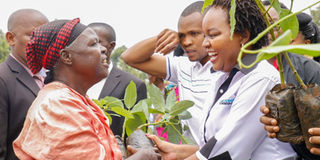The magic pill and fruits that Kirinyaga is reaping from heavy investments in health care and food production
Sponsored by County Government of Kirinyaga

The new complex at Kerugoya County Referral Hospital.
By Reginah Kinogu
Bit by bit, fewer and fewer residents of Kirinyaga will need to travel outside the county for medical procedures.
It is now eight years since Kenya devolved its health sector with the creation of county governments, and through the years, Kirinyaga County Government has made significant investments in the sector, achieving one milestone after another.
The county government says it is not done yet, and continues to expand the region’s health care infrastructure. While some construction and refurbishment projects have been completed, others are going on and more are being initiated. The county government says it wants to ensure that both ordinary and specialised medical needs can be fulfilled within the county’s borders.
Already, county residents admit that access to treatment has improved. Also, the previous inconveniences of patients having to travel distances, often to Muran’ga, Nyeri or even Nairobi for some medical services, are, to a large extent, no more. This is because more health facilities have been built or refurbished and equipped with necessary infrastructure.
Currently, the county government, under the leadership of Governor Anne Waiguru, is in the final stages of upgrading Kerugoya Hospital from a level-four to a level-five facility, to make it Kerugoya County Referral Hospital (KCRH).
Part of this has entailed refurbishing some infrastructure, among them the outpatient wing and TB isolation ward, as well as auxiliary facilities such as the Kitchen, laundry, incinerator and others.
The mega improvement here has entailed construction of a new complex at the hospital, containing a total of 342 beds. Five of these are in the theatre recovery section. The Intensive Care Unit (ICU) has 15 beds, while the High Dependency Unit (HDU) has six. Other bed allocations are eight in operation theatres, 30 in the paediatric surgical wards, 14 in the burns unit, and 36 in the female medical wards. The paediatrics medical ward (Wing B), female and male surgical wards (Wing A), have 48, 36 and 54 beds respectively. The Oncology wards, both male and female (Wing A), have 36 beds, while the male medical wards (Wing B) have 54 beds.
Additionally, the new complex has a CT scan to improve imaging, diagnosis and treatment of the patients. Word from the county government is that the Ksh1.2 billion complex will be ready in December 2021.
Meanwhile, the county government has completed and equipped numerous specialised clinics. They include Kerugoya and Kianyaga eye units, Sagana X-ray Centre, Kimbimbi and Kianyaga maternity wards and Baricho male ward.
Kirinyaga County Government has also constructed and equipped 19 dispensaries across the county to ensure health care services are available much closer to the grassroots.
Still in the health sector, the county government is in the process of upgrading Kiririmbi and Kianyaga hospitals from level-three to level-four facilities.
Food production

Kirinyaga County Governor Anne Waiguru during a visit to a poultry farm run by one of the groups supported by the county government to increase egg production.
In crop, poultry and livestock production, the county government introduced a stimulus programme known as Wezesha Kirinyaga. The inaugural phase of the programme has involved empowering 159 community groups. Later, the programme will be replicated across the entire farming fraternity.
Presently, the county government is supporting projects in four agricultural value chains, namely poultry, dairy, tomato and avocado.
The “ground-breaking one million eggs project”, as the county government refers to it, has taken off with 32 community groups rearing 1,250 layers each and producing at least one million eggs per month.
The farmers, drawn from 640 households, get guaranteed returns, since the county government markets the eggs on their behalf through the Kirinyaga Investment Development Authority.
The second phase of the project has started with 45 more groups having been registered. The aim is to replicate the project to increase production to five million eggs per month by 2022.
The project was informed by a huge deficit in local egg production.
To ensure all the farmers got the right breed of layers, the county government acquired chicks from a certified breeder on behalf of the groups. A total of 40,000 chicks were distributed to farmers in the project.
Besides keeping layers, families will still have time to undertake other income-generating activities, thereby increasing their household incomes further. Once the eggs are collected, they are taken to a cold storage facility located at Kiaga, for packaging and branding before delivery to the market.
In the dairy sector, the county government is offering artificial insemination services for free. This is aimed at improving the local breeds for higher milk production.
The county government is also promoting pig farming. At least 20 groups have benefitted, each getting 15 piglets and two sows.
How about fish farming? Well, the county government says some 20 groups will receive 6,000 fingerings each to start them off. Groups inclined to beekeeping, on the other hand, get beehives, harvesting kits and processing equipment. So far, 20 groups have benefitted.
In the horticulture segment, the county government has supplied a total of 71 groups with greenhouses.
Avocado production is now a big investment too. To help Kirinyaga farmers get a piece of the expanding local and international avocado markets, the county government has distributed more than 300,000 seedlings to promote large-scale production of the fruit. The ultimate plan is to put up an avocado factory and packing plant.

Kirinyaga Governor Anne Waiguru distributing avocado seedlings to farmers.


